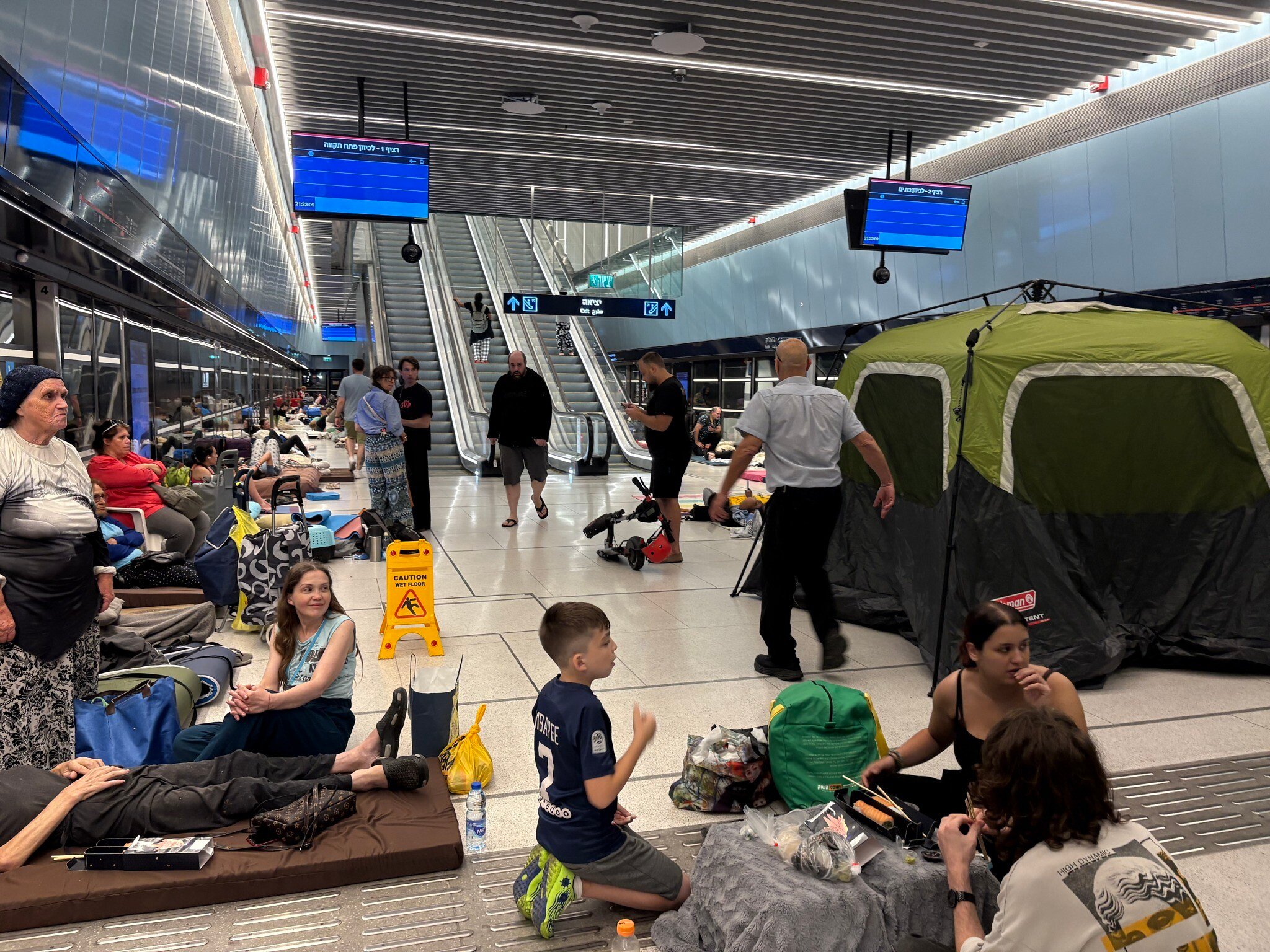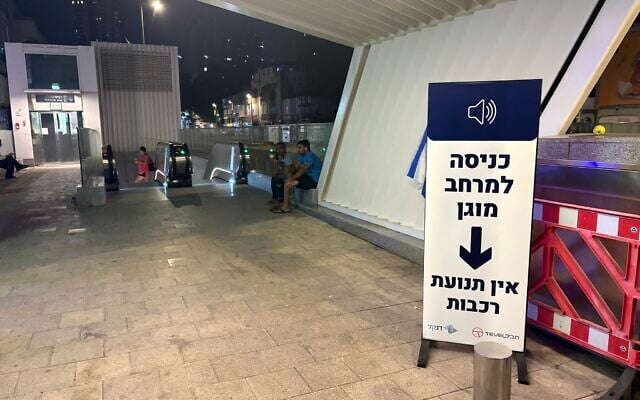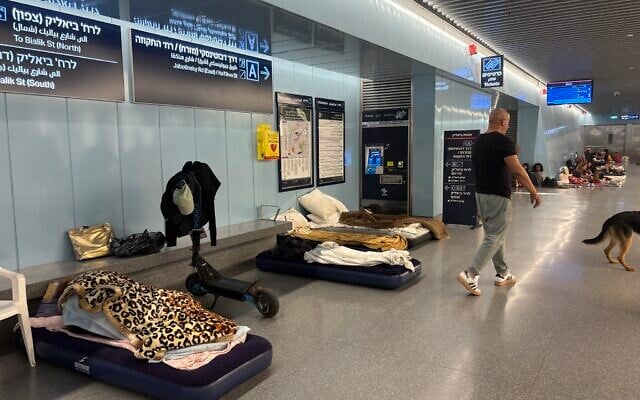



Lit by neon signs, pulsing with foot traffic, packed with bars, falafel joints and cafés that spill out onto the sidewalk, Bialik Street is usually one of the liveliest arteries in Ramat Gan. On a normal weeknight, you’d hear music from open windows, laughter from street corners, delivery scooters weaving through the crowd.
But on the fourth night in a row of Iranian missile strikes, the street is eerily silent, following a Home Front Command alerting residents to remain close to protected spaces.
The restaurants are dark. The windows are shuttered. There are no strollers, no couples walking home, no late-night smokers leaning against the curb. Just empty pavement, and the low hum of the light rail beneath your feet.
Then, suddenly, signs of life appear.
At the entrance to the Bialik light rail station, a small crowd has gathered. Some smoke quietly by the door. Others sit on benches, scrolling through their phones or chatting in low voices. Several signs mark the station not as a transit hub, but as a protected space — a public shelter with a new, urgent purpose.
Those descending the escalator are greeted by a surreal scene: rows of mattresses line the floors of the train platforms, each claimed by someone who has nowhere safer to sleep. Families unpack meals, children burrow into sleeping bags, friends chat quietly in corners.

This is what night looks like now in the heart of Israel’s most densely populated region — not in the bars and boulevards, but 92 feet deep underground, where a subterranean ecosystem has formed over the last four days.
Since Friday, when Iran began launching its missile salvos toward central Israel, some 1,000 people have taken shelter in Bialik Station each night. Most begin arriving around 9 or 10 p.m., though a few come as early as 4 p.m.
Many return every evening, even when the Home Front Command says it’s no longer necessary. For them, the risk above ground feels too great and the alternative too uncertain.
Tatiana, 27, stands beside a mattress on the lower level, keeping watch while her partner Ilia, 26, searches upstairs for a new spot; there was no more room below. It was their first night at the station, after spending previous nights at public shelters. Though their building has a shelter, she explained, it’s small, overcrowded and poorly maintained — much like the other public shelters they’ve tried.
A former English teacher from Russia who is now working at H&M, Tatiana looked calm but visibly frustrated.
“We were at a public shelter before,� she said. “It didn’t feel protected. It doesn’t feel safe at home, either.�
Around her, the station pulsed with the quiet rhythm of people settling in for the night. It’s a strange and sobering sight: families wrapped in blankets on thin mattresses, workers eating dinner from plastic containers, children sprawled on mattresses watching YouTube on a phone. A few played cards. Others lay silently with earbuds in. All were waiting — for morning, for quiet, for safety.

The scene feels dystopian, evoking a different place and era: Londoners huddled in the Underground during the Blitz; Ukrainians riding out airstrikes in the Kyiv metro. And now, in the heart of central Israel, a similar reality has taken hold.
There’s a palpable heaviness and frustration that hangs in the air. Many are here because their homes lack adequate shelters — or any shelters at all.
Bialik Station is neat, organized and not overcrowded, in contrast to many public shelters and other shelters in most residential buildings. It boasts clean bathrooms, air conditioning, Wi-Fi and coordinated management, offering a safer, more humane alternative for many residents.
Station employees patrol the space throughout the night, not as train staff but as temporary wardens: distributing mattresses and supplies, mediating disputes and ensuring the tightly packed floor stays clean and usable. When one man set up a tent for privacy, they gently asked him to take it down. Tents take up too much space — a scarce and precious resource.
The result is an underground space that functions better than many of the public shelters purpose-built for emergencies.
On the upper level, Sura, 42, and Naveen, 39, sat side by side on a pair of mattresses, sharing a pizza they brought with them. The two friends, originally from India, came to Israel in the past two years as foreign workers to send money back to their families.

They work together at a nearby supermarket and have come here every night since the strikes began.
“There’s no miklat in our building,â€� Sura said, using the Hebrew term for shelter. “This place isn’t far. It’s clean and there’s space.â€� They stay until 5 a.m., then head home to change and go to work.
A large number of those sleeping in the station each night are foreign workers like Sura and Naveen, or immigrants from Russia and Ukraine. Many have no family nearby, few community ties and limited resources. For them, the station offers not just protection, but a rare sense of stability.
This is a miserable situation to be sure, but this isn’t a miserable place. Even laughter can ring out. The normalcy of it all is almost disarming.
Photographer Avishai Finkelstein, who lives nearby, came to document the light rail station turned bomb shelter.
“We never thought we’d have a functioning light rail here and it finally happened. Then we didn’t expect it to work,� he said. “And it works.�
He said it with a kind of sad irony: The long-awaited, long-delayed Tel Aviv-area light rail, whose first line was only opened in August 2023, is now functioning as a bomb shelter.
Yet, it has become one of the few things in this moment that’s functioning. Not as it was intended, but as it must.
